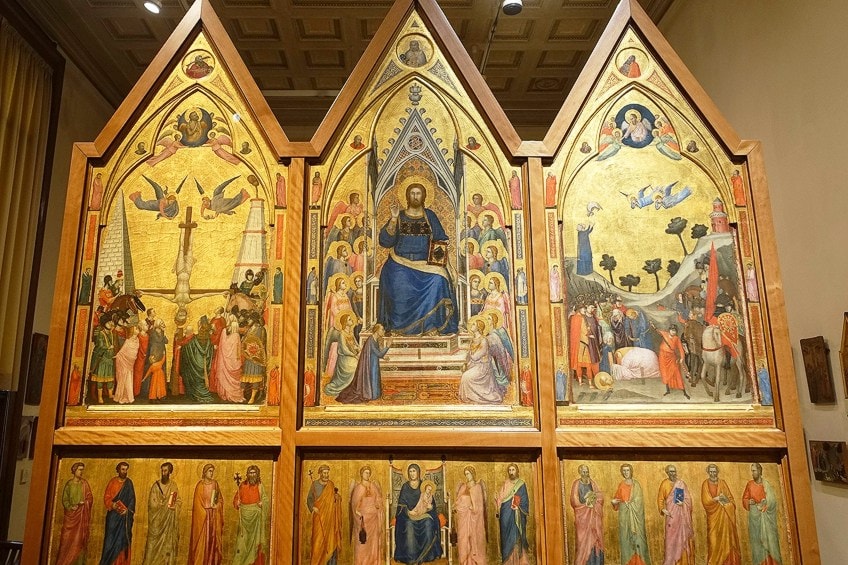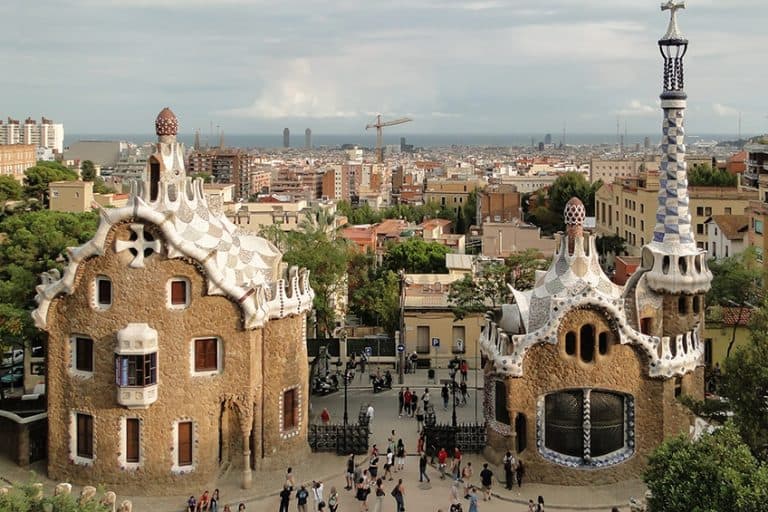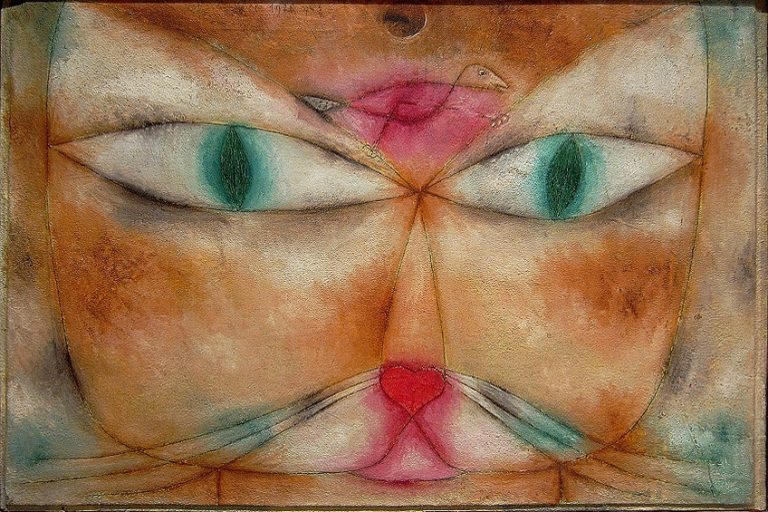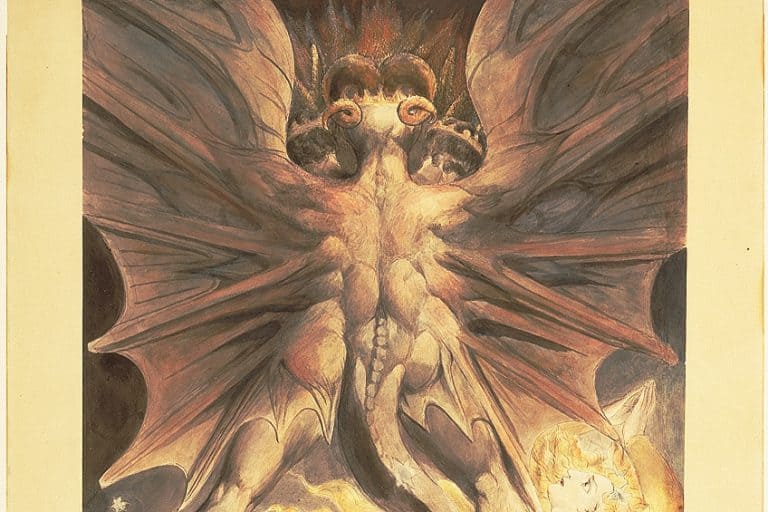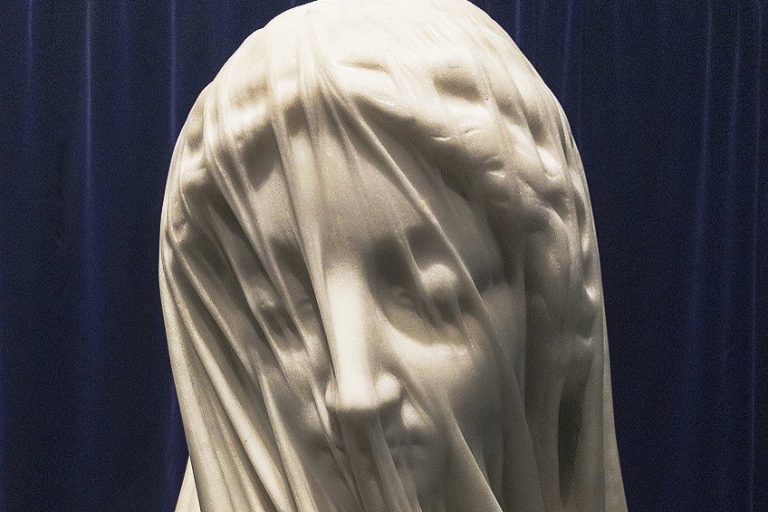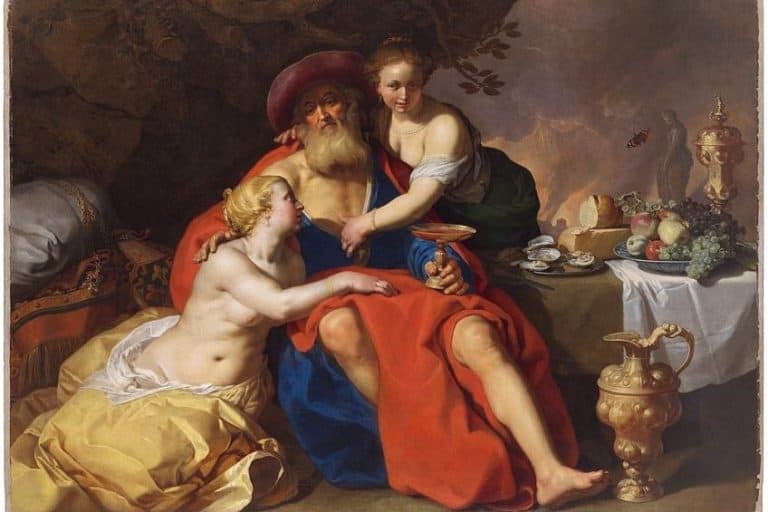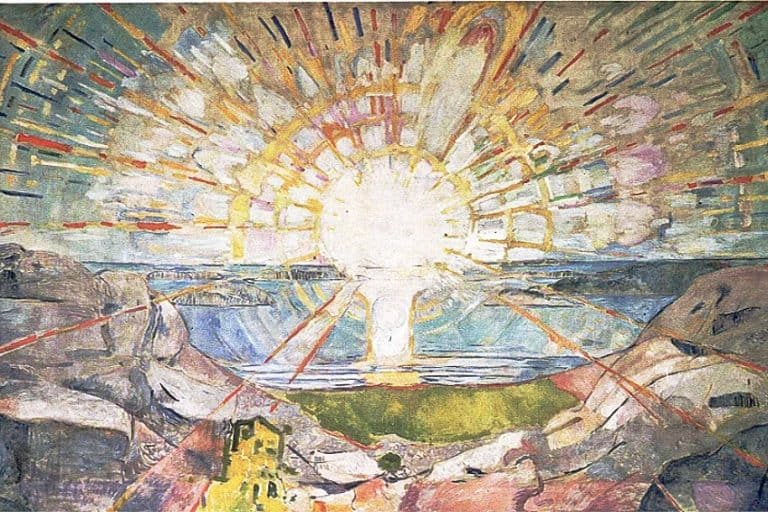What Is a Triptych? – Looking at the Best Triptych Examples
What is a Triptych? Triptych artworks are typically divided into three separate panels which can usually be closed and opened due to hinges. In triptych paintings, the center panel is typically the largest of the three. Today we will be learning more about triptych artworks and looking at some famous triptych examples.
What Is a Triptych?
The triptych shape may be seen in Christian Iconography and became a common conventional style for altar artworks in the Middle Ages. Its geographical span extended from the Byzantine buildings of the east to the western Celtic churches. Triptychs, among other remnants such as symbols, were frequently employed for private religious usage throughout the Byzantine era. It was also utilized by sculptors. Triptych shapes are very convenient for transportation.
Altarpieces in churches and cathedrals were frequently in triptych style from the Gothic era forward, both in Europe and overseas.
Llandaff Church is one such cathedral with a triptych altarpiece. Rubens’ two versions may be seen at the Cathedral of Our Lady in Antwerp, Belgium, and Notre Dame de Paris is another instance of triptych in construction. The construction of many church stained-glass windows echoes the shape.
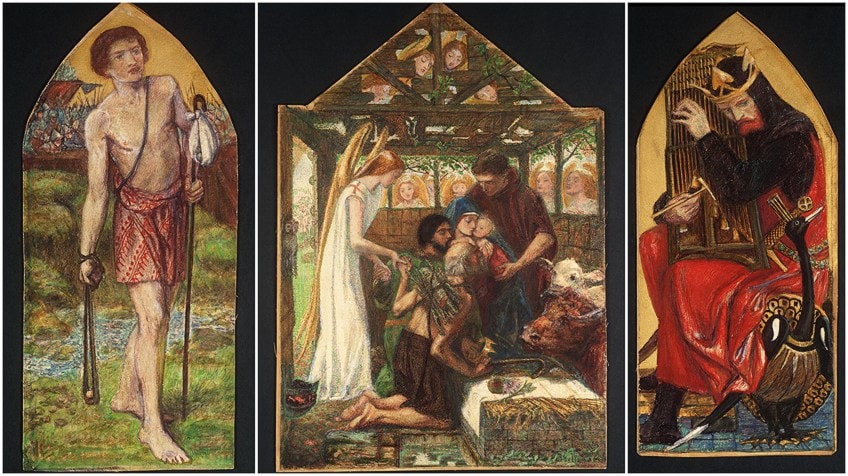
Despite being firmly associated with the altarpiece format, triptychs have been constructed outside of that setting, with some of the most well-known examples being works by Francis Bacon, Hieronymus Bosch, and Max Beckmann.
In November 2012, the top amount ever obtained for a painting auctioned was $142.4 million for Francis Bacon’s triptych, “Three Studies of Lucian Freud” (1969).
The last all-time high of $179.4 million was set in May of 2015 for Pablo Picasso’s artwork Les Femmes d’Alger (1955). The format has spread and is now utilized in other religions such as Buddhism and Islamic Faith. A volume of the Qur’an at the Museum of Turkish and Islamic Arts in Turkey and the Hilje-j-Sherif exhibited at the National Museum of Oriental Art in Rome are two triptych examples of Ottoman Islamic art that incorporate the theme. Tibetan Buddhists, too, have utilized it in ancient altars.
Famous Triptych Examples
A triptych artwork is a three-piece or three-panel piece of art. Since its inception, the triptych has continued to provide a new layer to visual art, often used to transmit a story, establish a sequence, or depict distinct components of the same subject matter. A triptych painting can also be used to divide a single work of art into three parts or to integrate three components into one. Let us now look at a few famous triptych examples.
Stefaneschi Triptych (c. 1330) by Giotto
| Artist | Giotto (1267 – 1337) |
| Date | c. 1330 |
| Dimensions | 178 cm x 89 cm |
| Current Location | Pinacoteca Vaticana, Rome. |
This triptych artwork is an uncommon instance of a recorded commission in Giotto’s works, and it bears Giotto’s signature, although the date, like most dates for Giotto, is contested, and many experts believe it was executed at the artist’s studio. It was long assumed to have been constructed for the church’s main altar; however, new research reveals that it was put on the “canon’s altar,” which is positioned in the nave, immediately to the left of the massive arched entry into the transept.
The altar was standalone, and the altarpiece was decorated on both sides so that the audience could view it from the front and the elders of the church could view it from the rear.
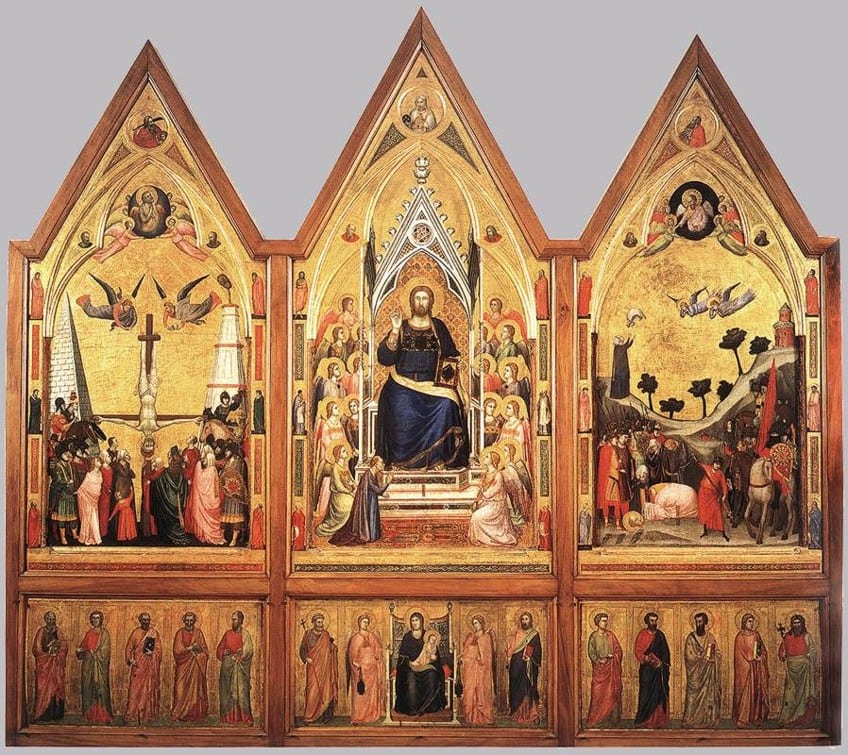
The main front panel depicts Saint Peter seated, accompanied by saints, with Cardinal Stefaneschi bowing to Peter’s side, presenting this altarpiece in miniature. Saints Paul and James are depicted on the left panel, while Saints Andrew and John are portrayed on the right. Two of the three predella panels have been destroyed, although they all must have depicted half-length statues of saints.
The rear main panel depicts Christ seated, surrounded by angels, with Cardinal Stefaneschi sitting at his right foot. The death of Peter is depicted on the left panel, while the execution of St. Paul is depicted on the right. The predella displays the Virgin and Child in the middle, surrounded by angels, and the 12 disciples standing on the sides.
The triptych was situated before the apse of Old St. Peter’s, which had a mosaic depicting Christ seated between Saints Peter and Paul in the 14th century.

Therefore, the front iconography of the picture resembled the apse mosaic in shape but did not replicate it in iconography. The middle screen of the altarpiece’s back replicated the apse mosaics for those who couldn’t see it since they were seated with their backs to it, while the side panels offered tales. In this era, it was common for double-sided altarpieces to contain an iconic picture on the front and story imagery on the reverse. Peter imitates Christ’s position to stress the function of the pope, as Peter was the first pope to serve as Christ’s earthly ambassador.
Mérode Altarpiece (1428) by Robert Campin
| Artist | Robert Campin |
| Date | 1428 |
| Dimensions | 121 cm x 242 cm |
| Current Location | The Cloisters, New York City |
The provenance of the triptych has sparked extensive scholarly discussion. It appears to have been finished in 1432, the same year as the Ghent Altarpiece, rendering the artist a contemporary of Jan van Eyck. It is commonly agreed that it is part of a set of paintings linked with the Master of Flémalle, who is supposed to be Robert Campin. Based on the realistic style that became van der Weyden’s trademark, it was credited to Campin’s pupil Rogier van der Weyden for a while. In Brussels, there is a somewhat older but ruined variant of the Annunciation panel, which may be the real version by Campin.
The scientific analysis of the wood panels indicates that the triptych was produced by several hands.
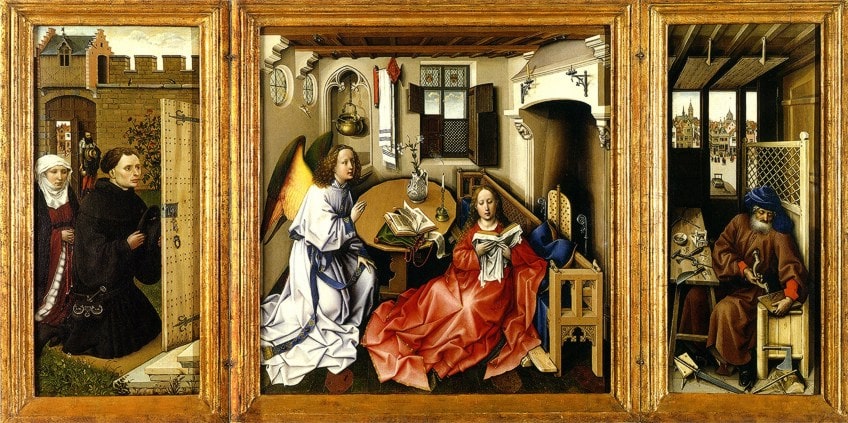
The middle panel’s wood is distinct and older than that of the sides, and the hinging suggests that it was not meant to be part of a triptych. The core panel is most likely a replica of an older work by Campin, whilst the wings were most likely commissioned later by the donor to join the main panel to make a tiny private religious altarpiece.
Some of the pieces have been changed; for example, the female contributor and bearded man on the left wing were repainted over the landscape, while the window behind the Virgin was initially created in gold.
The relationship with the Flemalle group, and hence Robert Campin, does not persuade Campbell. The Mérode, he says, is “nonsensical in design,” lacking Campin’s customary quality of spatial consistency, as shown in the Seilern Triptych. The free sky visible through the central panel windows contrasts sharply with the street scene depicted in the donor panel.
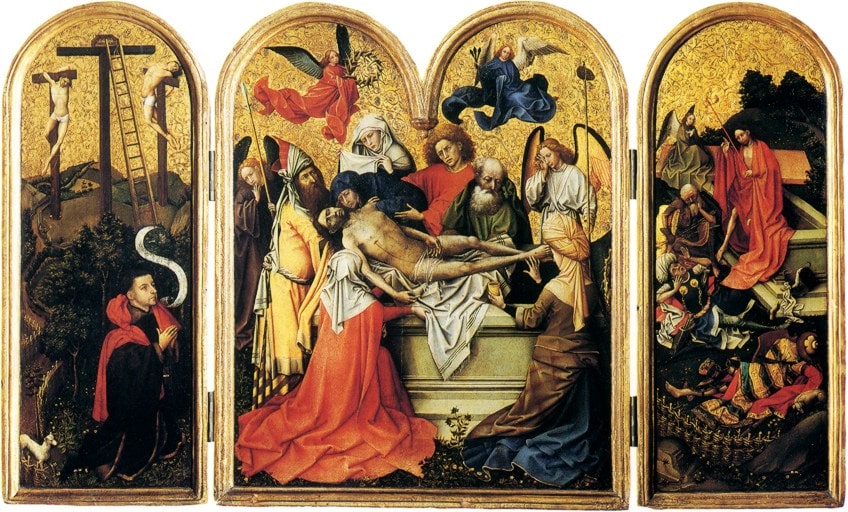
Campbell criticizes the donor panel’s lack of perspective, saying it’s “saddening that a line of one of the mortar divisions in the garden wall disappears into the donor’s lips.” The wing panels, according to Campbell, are pedestrian and the work of inexperienced workers. He emphasizes the Brussels panel, which he hesitantly credits to the Master of Flémalle.
Portinari Altarpiece (1477) by Hugo van der Goes
| Artist | Hugo van der Goes |
| Date | 1477 |
| Dimensions | 254 cm x 304 cm |
| Current Location | Galleria degli Uffizi, Florence |
Three shepherds kneel before the young Jesus in the middle panel. Van der Goes depicted these rural people with great realism. Bowing angels encircle the Virgin and Child, who is not in a cradle but rather rests on the earth encircled by a gold ray incandescence. This remarkable depiction of Jesus’ devotion is most likely inspired by one of Saint Bridget of Sweden’s visions.
Van der Goes portrayed images connected to the primary topic in the background: Joseph and Mary on the journey to Bethlehem on the left panel; the shepherds addressed by the angel on the middle panel (to the right); and the Three Visitors on the way to Bethlehem on the right panel.
Hugo van der Goes employed a continuous storyline to depict the same people in many paintings. In the center panel, he first places the people in the backdrop.
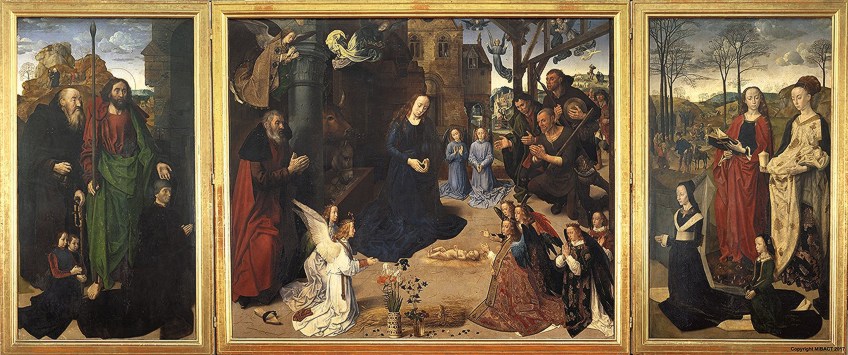
An angel is visible over the heads of the shepherds in this image. This is the Annunciation of the Shepherds, in which the angel appears to the shepherds to inform them of Christ’s birth. The shepherds are now worshiping Jesus across from the Virgin Mary in the forefront of the center panel. Since most triptych altarpieces are closed, the Portinari Altarpiece would have been kept closed with the exception of rare occasions like feasts and high holidays, when it would have been reopened.
The Annunciation scene is depicted decoratively on the outside of Hugo van der Goes’ triptych.
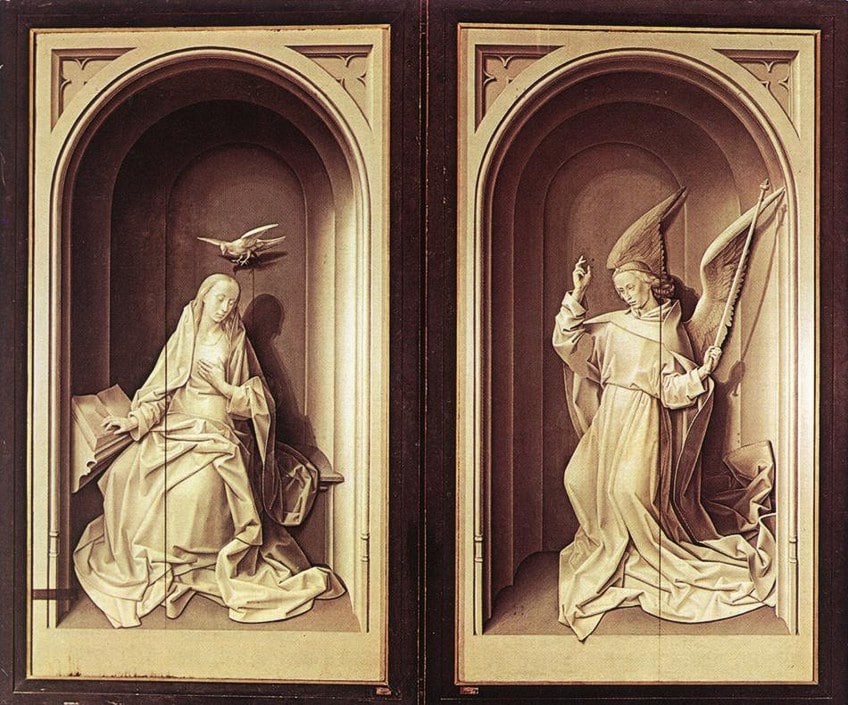
It was more cost-effective for a patron to commission a painter like Hugo van der Goes, who could make a painting and a sculpture out of paint alone. This enabled the patron to hire simply the artist rather than a number of craftspeople. Van der Goes benefited as well since the whole commission could be preserved for the artist and his helpers. Another popular Hugo van der Goes notion was to represent the scene of The Annunciation on the outside of the triptych while the image from Christ’s life would be in the inside of the altarpiece after the panels were open, as The Annunciation gave way to Christ’s Incarnation.
Buhl Altarpiece (c. 1500) by Followers of Martin Schongauer
| Artist | Followers of Martin Schongauer |
| Date | c. 1500 |
| Dimensions | 197 cm x 700 cm |
| Current Location | Église Saint-Jean-Baptiste, Buhl, Haut-Rhin |
The colorful Buhl altarpiece was created by a group of Martin Schongauer followers who were inspired by both his woodblock prints and his canvases, particularly the Altarpiece of the Dominicans, which is currently housed in the Unterlinden Museum. The designs of the Buhl artists were carefully copied by their models, albeit on a greater scale and in a lower and practically sloppier way.
While it is not recorded that the altarpiece was appointed by the friary of Saint Catherine, the similarities to the design features of Schongauer and, to a smaller extent, Caspar Isenmann.
The panel portraying Christ’s Flagellation is similar to the very same picture in the altarpiece of St Martin’s Church – imply without a reason to suspect that it was painted in Colmar; additionally, both Saints Ursula and Catherine, who feature heavily in the Crucifixion scenario.

There has been speculation that Schongauer’s disciple Urbain Huter (1471–1501) was one of the authors, but no substantial proof has been found. Buhl has a record of the altarpiece since 1835. From 1868 until 1899, the current parish church – a Neo-Romanesque structure with a large and majestic nave and a small and narrow choir (in which the altarpiece is placed) – was erected in three parts.
The altarpiece departed Buhl twice: once during WWII, when it was concealed in Périgueux, and then again from 1966 until 1971 when it was renovated in Paris and shown in Colmar’s Unterlinden Museum. In 1988, the “Friends of the Buhl Altarpiece” formed a local chapter. The Agony in the Garden and Christ’s Flagellation are shown on the front of the left side wing.

The Crucifixion of Jesus is shown on the front of the middle panel, along with Saint Catherine and Saint Ursula. These two women figures, which are portrayed in a more Proto-Renaissance manner than the others, may have been created last. The right wing’s front side depicts the Crowning with Thorns and the Bearing of the Cross from Jesus’ Passion.
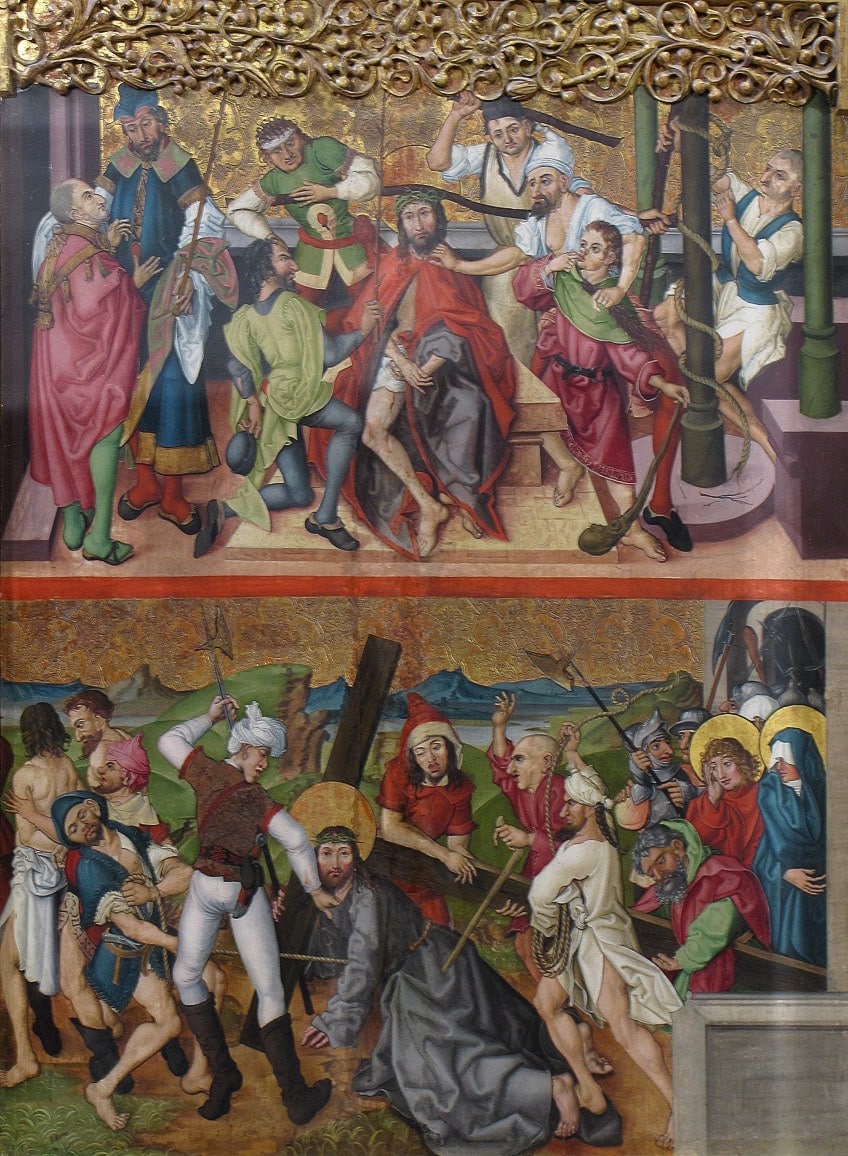
The Nativity of Jesus and the Assumption of Mary are shown on the backside of the left wing.
The middle panel’s back (done in a different manner and in poorer condition than the remainder of the altarpiece) depicts the Last Judgment as a dread. The right panel’s back features the Annunciation with the Unicorn (nearly an identical replica of the same subject from the Dominicans’ Altarpiece) and the Adoration of the Magi. Surprisingly, in the Last Judgement, both the good in the picture of Paradise and the condemned in the image of Hell are virtually entirely clergy individuals: papacy, priests, nuns, and monks.
The Elevation of the Cross (1610-1611) by Peter Paul Rubens
| Artist | Peter Paul Rubens |
| Date | 1610-1611 |
| Dimensions | 462 cm x 341 cm |
| Current Location | Cathedral of Our Lady, Antwerp |
The major themes of this artwork are Jesus Christ and the ascent of his crucifixion, with elements of the tale spilling over from the central panel onto the wings on both sides. This altarpiece is an early effort by Rubens to incorporate the ferocity of the Baroque period. The scene is gloomy and tense as a crowd of onlookers, troops, horses, and the tense bodies of the killers around the soon-to-be crucified Christ.
Rubens stresses Christ’s voluntary sacrifice above the horrors of his crucifixion by depicting Jesus’ corpse as a vision of classical grandeur, with arms uplifted and eyes focused skyward. Christ’s agony is seen in his tight and rigid physique, palms clasped tightly around the nails in his hands, and head distorted in the final seconds of agony.
The three panels work in tandem to create a seamless scene.
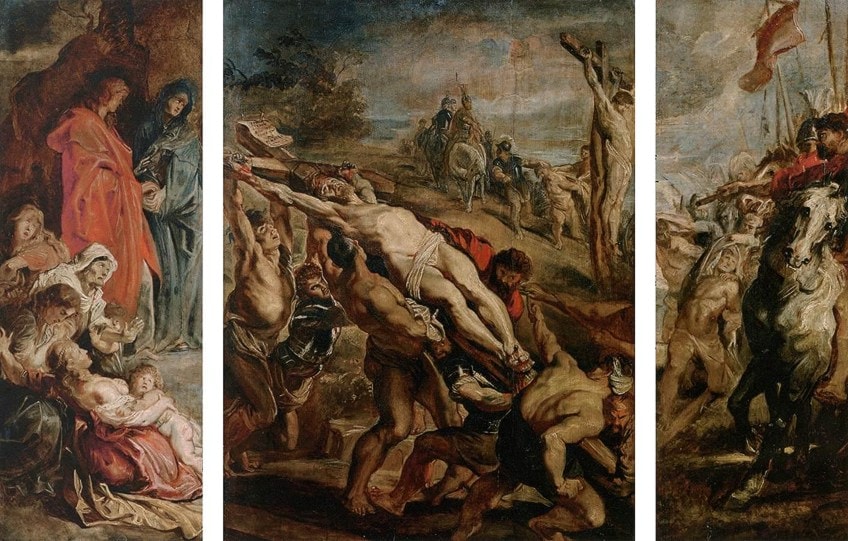
The center panel depicts a conflict between a swarm of hugely muscled men striving to hoist the cross and the almost insurmountable weight of Christ on the crucifixion. Christ looks up and begs his father, who is shown above the triptych, to pardon his persecutors, saying, “Lord, forgive them because they know not what they do.”
As the Roman officers announce their commands, the criminals in the right-wing are being prepped for death. The ladies on the journey respond to Christ’s request for mercy on the left wing, repeating the phases of remorse figure by figure: fearfulness, remorse, faith, and compassion toward the Messiah.
Rubens juxtaposes the singularity of Christ’s request for mercy with references from old images of godly retribution.
Above them, the Virgin and Saint John are identified as greatly touched, contemplating on the significance of the lifting of the crucifix and Christ’s appeal for forgiveness. As the Roman officers announce their commands, the criminals in the right-wing are being prepped for death. The Council of Trent had a great influence on Rubens’ subject matter and topics. By showing the triumphant essence of Christ’s death while retaining his divinity, Rubens embodies the spirit of the Catholic Reformation.
And that brings to an end our look at famous Triptych artworks. Triptych paintings are typically divided into three separate panels which can usually be closed and opened due to hinges. In most triptych examples, the center panel is typically the largest of the three. The triptych shape may be seen in Christian iconography and became a popular traditional design for altar artworks during the Middle Ages.
Take a look at our Triptych art webstory here!
Frequently Asked Questions
What Is a Triptych?
Its geographical range spanned from eastern Byzantine structures to western Celtic churches. Throughout the Byzantine era, triptychs, as well as other remains such as symbols, were widely used for private religious purposes. Renaissance painters such as Hieronymus Bosch as well as Hans Memling used the form. Sculptors also made use of it. Triptych forms are ideal for transporting.
What Is the Purpose of a Triptych?
A triptych artwork is a three-piece or three-panel piece of art. Since its inception, the triptych has continued to provide a new layer to visual art, often used to transmit a story, establish a sequence, or depict distinct components of the same subject matter. A triptych painting can also be used to divide a single work of art into three parts or to integrate three components into one.
Isabella studied at the University of Cape Town in South Africa and graduated with a Bachelor of Arts majoring in English Literature & Language and Psychology. Throughout her undergraduate years, she took Art History as an additional subject and absolutely loved it. Building on from her art history knowledge that began in high school, art has always been a particular area of fascination for her. From learning about artworks previously unknown to her, or sharpening her existing understanding of specific works, the ability to continue learning within this interesting sphere excites her greatly.
Her focal points of interest in art history encompass profiling specific artists and art movements, as it is these areas where she is able to really dig deep into the rich narrative of the art world. Additionally, she particularly enjoys exploring the different artistic styles of the 20th century, as well as the important impact that female artists have had on the development of art history.
Learn more about Isabella Meyer and the Art in Context Team.
Cite this Article
Isabella, Meyer, “What Is a Triptych? – Looking at the Best Triptych Examples.” Art in Context. December 23, 2021. URL: https://artincontext.org/what-is-a-triptych/
Meyer, I. (2021, 23 December). What Is a Triptych? – Looking at the Best Triptych Examples. Art in Context. https://artincontext.org/what-is-a-triptych/
Meyer, Isabella. “What Is a Triptych? – Looking at the Best Triptych Examples.” Art in Context, December 23, 2021. https://artincontext.org/what-is-a-triptych/.


